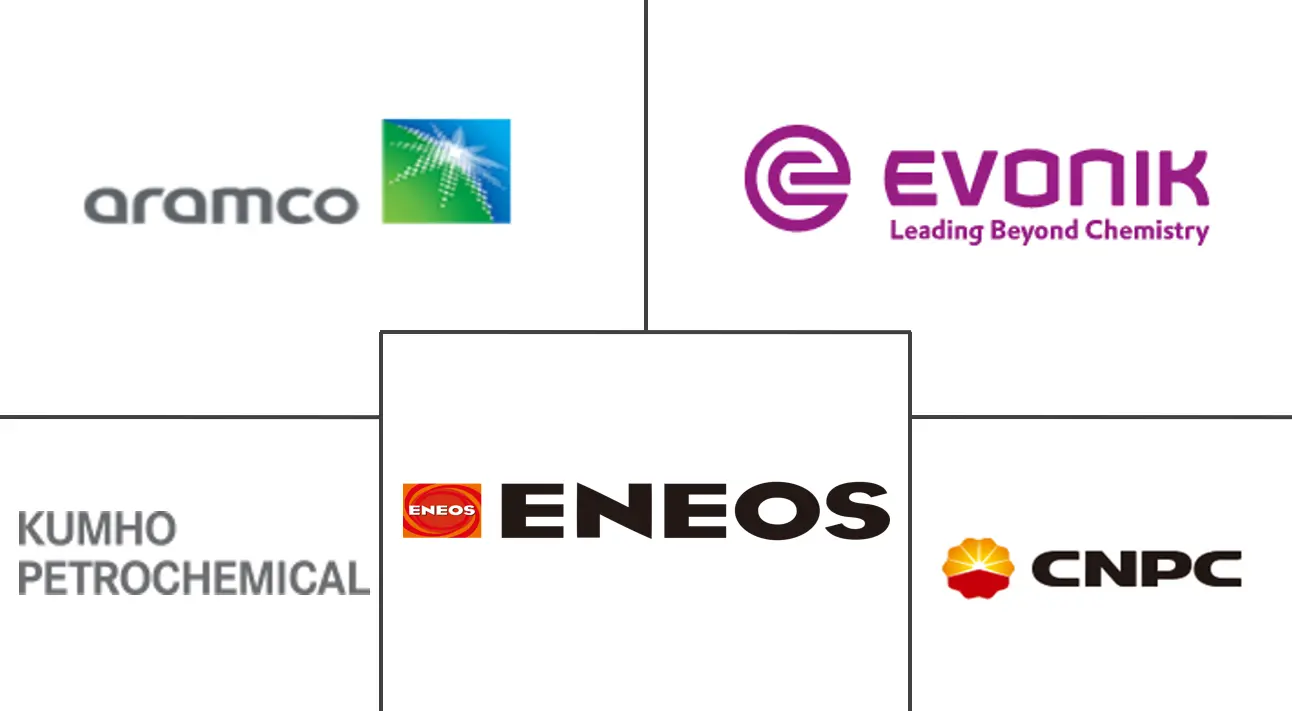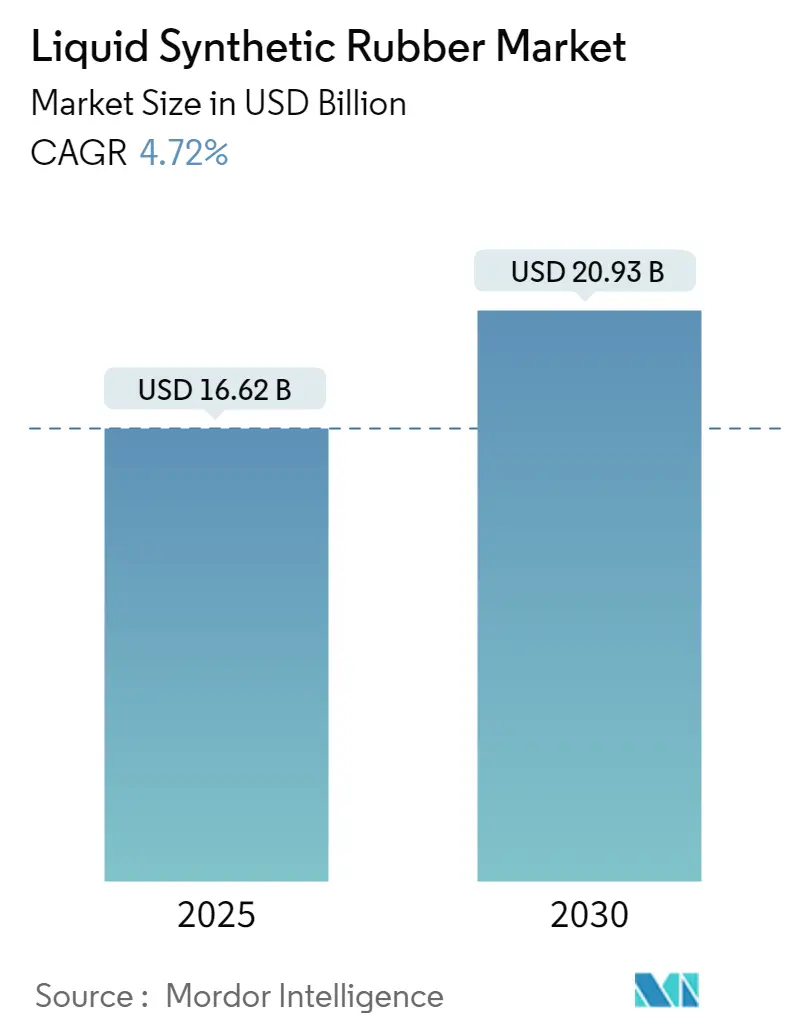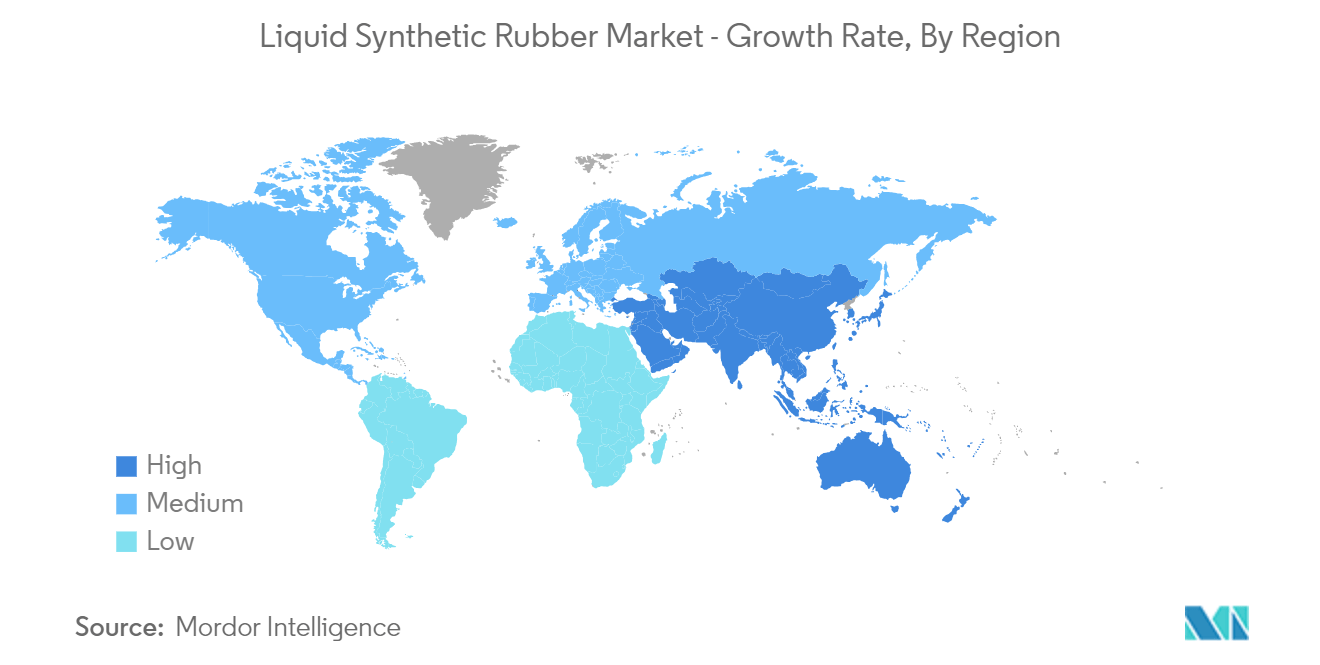Liquid Synthetic Rubber Market Analysis
The Liquid Synthetic Rubber Market size is estimated at USD 16.62 billion in 2025, and is expected to reach USD 20.93 billion by 2030, at a CAGR of 4.72% during the forecast period (2025-2030).
Liquid synthetic rubber plays a pivotal role in several industrial sectors, including adhesives, tire manufacturing, and various industrial rubber products, due to its unique properties and versatility. The increasing demand for these products has had a significant impact on the growth of the liquid synthetic rubber market. Moreover, ongoing advancements in polymer modification and niche applications like waterproofing coatings and footwear are further contributing to the market's expansion.
Product Segmentation and Regional Insights
- Diverse Product Types: The liquid synthetic rubber market is segmented by product type, including liquid isoprene, liquid butadiene, liquid styrene butadiene, and others such as liquid EPDM and liquid NBR. Each product type is tailored to specific applications, making them essential in various industries. For instance, liquid butadiene is widely used in the automotive industry for tire production, while liquid EPDM is favored in construction for waterproofing solutions.
- Geographic Market Leaders: The market is geographically segmented into regions such as Asia-Pacific, North America, Europe, South America, and the Middle East and Africa. Asia-Pacific is the dominant player, driven by its robust manufacturing base, particularly in automotive and construction industries. North America and Europe also hold significant market shares due to their established industrial sectors and demand for advanced rubber products.
Growing Adhesive Sector Bolsters Market Demand
- Rising Demand in Adhesives: The adhesive industry is a major consumer of liquid synthetic rubber, where the material’s flexibility and strong bonding capabilities are highly valued. Applications span across automotive, construction, and packaging sectors, where high-performance adhesives are crucial. The push for more durable and versatile adhesive solutions is steadily increasing the demand for liquid synthetic rubber, especially in industries requiring robust and long-lasting bonding solutions.
- Sustainability and Innovation: As global trends shift towards sustainability, manufacturers are innovating liquid synthetic rubber formulations to reduce environmental impact while enhancing performance. This alignment with green chemistry and resource efficiency is further driving the adoption of liquid synthetic rubber in the adhesive sector, responding to both regulatory demands and consumer preferences for eco-friendly products.
Liquid Synthetic Rubber Market Trends
Surge in Global Tire Production Fuels Market Growth
- The tire segment's reliance on liquid synthetic rubber is growing, particularly in premium tire markets where flexibility, resilience, and durability are paramount. The automotive industry's expansion, coupled with consumer demand for advanced vehicles, continues to drive this trend. Additionally, the industry's shift towards sustainable materials is impacting liquid synthetic rubber pricing, reflecting the broader market movement towards environmentally friendly products.
- Tire Industry Contributions: The automotive industry's expansion, especially in emerging markets, has significantly boosted the demand for liquid synthetic rubber in tire manufacturing. Known for its elasticity and durability, liquid synthetic rubber is integral in producing high-performance tires that meet stringent quality standards. As the global automotive sector recovers and grows, particularly with the rise of electric vehicles (EVs), the demand for advanced tire solutions continues to drive market growth.
- Technological Advancements: Innovations in tire production, such as the development of low rolling resistance and high-performance tires, have led to increased reliance on liquid synthetic rubber. These technological advancements are essential for improving fuel efficiency and reducing carbon emissions, aligning with global environmental goals and regulatory pressures. The ongoing development of sustainable mobility solutions further amplifies the need for high-quality synthetic rubber in the tire industry.
Asia-Pacific Region to Dominate the Market
- The Asia-Pacific region is expected to dominate the global liquid synthetic rubber market, driven by rapid industrialization and a strong automotive sector. Countries like China, India, and Japan are key contributors to this growth, with the region's cost competitiveness and access to raw materials providing a significant edge over other markets. As the region continues to invest in research and development, its leadership in the liquid synthetic rubber market is poised to strengthen further.
Liquid Synthetic Rubber Industry Overview
- Fragmented Market Structure: The liquid synthetic rubber market is characterized by fragmentation, with numerous companies competing globally. While no single company dominates, key players have established significant market shares in their respective regions. This fragmentation fosters innovation and differentiation, enabling smaller companies to compete alongside industry giants. The competitive landscape is further defined by the diverse capabilities of leading firms, which cater to a wide range of industries, including automotive, construction, and adhesives.
- Strategies for Success: To thrive in this fragmented market, companies are focusing on product differentiation and strong customer relationships. The increasing demand for sustainable and high-performance materials is driving innovation, with manufacturers enhancing product characteristics such as durability and flexibility. Strategic partnerships and expansions into emerging markets are also critical strategies that companies are employing to bolster their market position and reach.
Liquid Synthetic Rubber Market Leaders
-
Evonik Industries AG
-
China National Petroleum Corporation
-
Kumho Petrochemical
-
ENEOS Corporation
-
Saudi Arabian Oil Co. (Arlanxeo)
- *Disclaimer: Major Players sorted in no particular order
Liquid Synthetic Rubber Market News
- July 2024: Dow launched NORDEL™ REN Ethylene Propylene Diene Terpolymers (EPDM), a bio-based version of Dow’s EPDM rubber material that goes into automotive, infrastructure and consumer applications.
- February 2024: Lion Elastomers and Emulco announced a Strategic Partnership for Water-Based EPDM Emulsion Products.
- August 2022: Lion Elastomers announced the USD 22 million expansion of the Geismar plant. The expansion will increase production capacity at the plant, supporting the supply chains of automobile tire manufacturers and producing a broad range of other rubber goods. With the reinvestment in its Geismar plant, Lion Elastomers will retain 176 Capital Region jobs.
Liquid Synthetic Rubber Industry Segmentation
Liquid synthetic rubber is a low-molecular-weight liquid polymer of synthetic rubber, mainly used in the production of tires and to improve the adhesive and polymer properties. Even at low temperatures, it offers good adhesion and improved coating and flow properties. The liquid synthetic rubber market is segmented by product type, application, and geography (Asia-Pacific, North America, Europe, South America, the Middle East, and Africa). By product type, the market is segmented into liquid isoprene, liquid butadiene, liquid styrene-butadiene, and other product types. By application, the market is segmented into adhesives, industrial rubber, tires, polymer modification, and other applications. The report also covers the market size and forecasts for the liquid synthetic rubber market in 15 countries across major regions. For each segment, market sizing and forecasts have been done based on revenue (USD).
| Product Type | Liquid Isoprene | ||
| Liquid Butadiene | |||
| Liquid Styrene Butadiene | |||
| Other Product Types (Liquid EPDM and Liquid NBR) | |||
| Application | Adhesives | ||
| Industrial Rubber | |||
| Tire | |||
| Polymer Modification | |||
| Other Applications (Waterproofing Coatings and Footwear) | |||
| Geography | Asia-Pacific | China | |
| India | |||
| Japan | |||
| South Korea | |||
| Rest of Asia-Pacific | |||
| North America | United States | ||
| Canada | |||
| Mexico | |||
| Europe | Germany | ||
| France | |||
| United Kingdom | |||
| Italy | |||
| Rest of Europe | |||
| South America | Brazil | ||
| Argentina | |||
| Rest of South America | |||
| Middle-East and Africa | Saudi Arabia | ||
| South Africa | |||
| Rest of Middle-East and Africa | |||
Liquid Synthetic Rubber Market Research FAQs
How big is the Liquid Synthetic Rubber Market?
The Liquid Synthetic Rubber Market size is expected to reach USD 16.62 billion in 2025 and grow at a CAGR of 4.72% to reach USD 20.93 billion by 2030.
What is the current Liquid Synthetic Rubber Market size?
In 2025, the Liquid Synthetic Rubber Market size is expected to reach USD 16.62 billion.
Who are the key players in Liquid Synthetic Rubber Market?
Evonik Industries AG, China National Petroleum Corporation, Kumho Petrochemical, ENEOS Corporation and Saudi Arabian Oil Co. (Arlanxeo) are the major companies operating in the Liquid Synthetic Rubber Market.
Which is the fastest growing region in Liquid Synthetic Rubber Market?
Asia Pacific is estimated to grow at the highest CAGR over the forecast period (2025-2030).
Which region has the biggest share in Liquid Synthetic Rubber Market?
In 2025, the Asia Pacific accounts for the largest market share in Liquid Synthetic Rubber Market.
What years does this Liquid Synthetic Rubber Market cover, and what was the market size in 2024?
In 2024, the Liquid Synthetic Rubber Market size was estimated at USD 15.84 billion. The report covers the Liquid Synthetic Rubber Market historical market size for years: 2019, 2020, 2021, 2022, 2023 and 2024. The report also forecasts the Liquid Synthetic Rubber Market size for years: 2025, 2026, 2027, 2028, 2029 and 2030.
Our Best Selling Reports
Liquid Synthetic Rubber Industry Report
Our comprehensive industry analysis delves into the expanding liquid synthetic rubber market, focusing on key trends, growth drivers, and emerging opportunities. The report highlights the critical applications of liquid synthetic rubber in sectors such as adhesives and tire manufacturing, where its unique properties are in high demand. This in-depth study provides a detailed overview of the market's diverse product segments, including liquid isoprene, liquid butadiene, and liquid EPDM, offering stakeholders valuable insights into product-specific market dynamics and regional market leadership, particularly in the Asia-Pacific region.
Stakeholders benefit significantly from our detailed liquid synthetic rubber market analysis, which is meticulously crafted to support strategic decision-making and market entry plans. The report offers a thorough examination of the industry's competitive landscape, with a particular emphasis on sustainability and technological innovation. Additionally, the comprehensive findings are presented in an easy-to-read report pdf, ensuring that all critical market data, trends, and forecasts are readily accessible for in-depth review and strategic planning.
Statistics for the 2024 Liquid Synthetic Rubber market share, size and revenue growth rate, created by Mordor Intelligence™ Industry Reports. Liquid Synthetic Rubber analysis includes a market forecast outlook 2029 and historical overview. Get a sample of this industry analysis as a free report PDF download.







